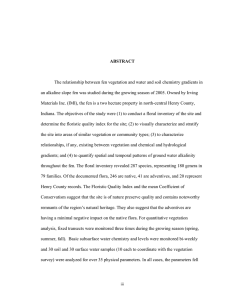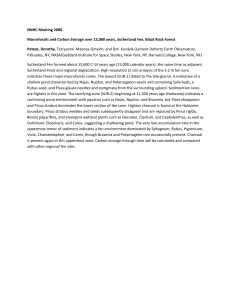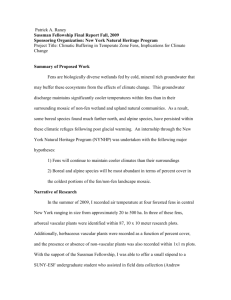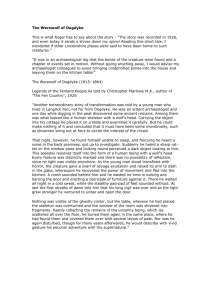Proposal: Tahoe Research Supported by SNPLMA Round 10
advertisement
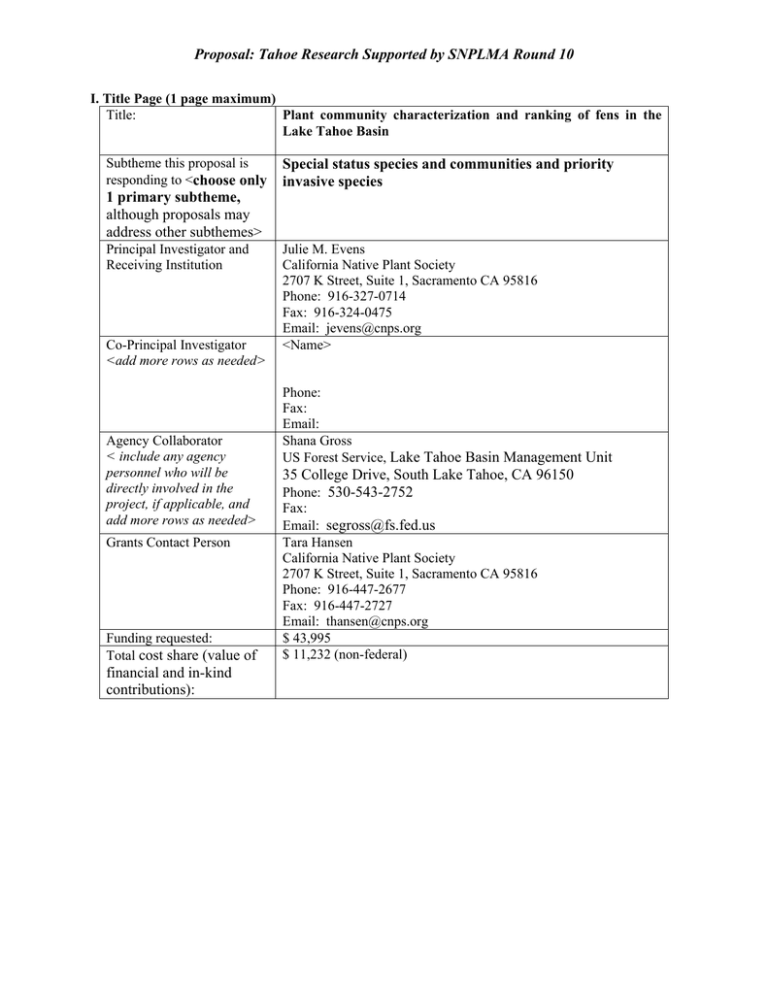
Proposal: Tahoe Research Supported by SNPLMA Round 10 I. Title Page (1 page maximum) Title: Plant community characterization and ranking of fens in the Lake Tahoe Basin Subtheme this proposal is responding to <choose only Special status species and communities and priority invasive species 1 primary subtheme, although proposals may address other subthemes> Principal Investigator and Receiving Institution Co-Principal Investigator <add more rows as needed> Agency Collaborator < include any agency personnel who will be directly involved in the project, if applicable, and add more rows as needed> Grants Contact Person Funding requested: Total cost share (value of financial and in-kind contributions): Julie M. Evens California Native Plant Society 2707 K Street, Suite 1, Sacramento CA 95816 Phone: 916-327-0714 Fax: 916-324-0475 Email: jevens@cnps.org <Name> Phone: Fax: Email: Shana Gross US Forest Service, Lake Tahoe Basin Management Unit 35 College Drive, South Lake Tahoe, CA 96150 Phone: 530-543-2752 Fax: Email: segross@fs.fed.us Tara Hansen California Native Plant Society 2707 K Street, Suite 1, Sacramento CA 95816 Phone: 916-447-2677 Fax: 916-447-2727 Email: thansen@cnps.org $ 43,995 $ 11,232 (non-federal) Proposal: Tahoe Research Supported by SNPLMA Round 10 II. Proposal Narrative (up to 7 pages, single-spaced, 10 point font minimum) A. Project Abstract: The California Native Plant Society proposes to monitor, map, and rank fens for their plant community diversity and quality within the Lake Tahoe Basin. We will analyze data from over 100 existing fen/montane wetland surveys to refine a vegetation classification system for fens in the region. We will establish a system for quantitatively ranking fens based on existing methods, and we will use existing fen data and collect additional monitoring data for at least 40 stands in order to sufficiently rank fen sites. We plan to focus efforts where initial reconnaissance/surveys have been undertaken by project partners, such as the US Forest Service (USFS). Collection of additional monitoring data and establishment of maps and rankings for fens will be useful to project partners and the public, so that they can make long-term conservation and management decisions to protect sensitive fen communities. B. Justification Statement: This project addresses both special status species and communities within the Lake Tahoe Basin. We intend to evaluate approaches to assess biological integrity and quality of fen communities in the Lake Tahoe Basin, collect data that allows this assessment for a subset of fens, and provide these tools to the agencies and public for future assessment and conservation purposes. Fens and Meadows have already been identified in the Tahoe Science Plan (Manley et al. 2009) as special communities, which are small in area, but have great functional importance. Specific fen sites, including Grass Lake and Hell Hole, have been designated by the Tahoe Regional Planning Agency as uncommon plant communities for which the threshold standard is to assure non-degradation of the natural characteristics of the community (TRPA 2007). They support a high diversity of species which are often restricted to these communities. Our project will address current knowledge gaps, including mapping of fens and associated meadows and describing their characteristics. The variation among fens in their ecological characteristics, vegetation types, and site conditions has yet to be fully documented and understood. Project priorities include monitoring, assessment and quantitative ranking of fen sites to identify high quality sites for protection and restoration. Tools for further assessment, monitoring, and ranking of fens will be evaluated and recommended. C. Concise Background and Problem Statement The protection and understanding of natural plant assemblages is a key objective of the California Native Plant Society (CNPS). The purpose of the CNPS Vegetation Program is to define their biotic patterns, to raise awareness of their importance and rarity, and to assist in conserving them at the “multispecies” level of biodiversity. We use classifications, definitions, and maps as means to identify and protect these natural units across the landscape. We have developed the state’s standard accepted protocol and classification system for sampling and describing vegetation though A Manual of California Vegetation, and we also recognize the importance of identifying and protecting rare plant communities (Sawyer et al. 2009). In 2008, CNPS entered a cooperative agreement with UC Davis, DFG, and USFS to compile and analyze existing information on fen vegetation for National Forests in the Sierra Nevada and Cascade Ranges of California, and we plan to continue efforts to better categorize and protect fen vegetation. Fens are peat-forming wetlands, produced by nearly constant groundwater inflow (Bedford and Goodwin 2003). Peatlands are formed and maintained only in a hydrologic regime of perennial soil saturation. Their permanently saturated condition creates oxygen-deprived soils with very low rates of decomposition, allowing the accumulation of organic matter produced by wetland plants (Cooper and Wolf 2006). The thickness of organic soil required for an ecosystem to be classified as peatland varies around the world. In Europe 30 cm of organic soil thickness is defined as sufficient (Moen 1995), while in the United States (Soil Survey Staff 1994, 1999) and Canada (Zoltai 1988) organic thickness must equal or exceed 40 cm to qualify as a peatland. The deep organic layer in fens means that plants root in the peat Proposal: Tahoe Research Supported by SNPLMA Round 10 and derive all, or almost all, of their water and nutrients from the peat, rather than the underlying mineral layer. In the Sierra Nevada, conditions for the accumulation of peat are improved by lower average annual air temperatures due to altitude, further slowing rates of decomposition. Fens are a widely distributed wetland type world-wide, particularly in the northern latitudes. However, fens are scattered across California, and they vary in botanical, ecological, geochemical, and hydrologic characteristics. Fens develop very slowly and persist for thousands of years over stable climatic periods. Fens also are hotspots of biological diversity. In California, the perennial supply of water provides refugia for several plant and animal species that persist only in fens. Many of these species have the main ranges of their distribution far to the north in Alaska and Canada (Chadde et al. 1998), with their southernmost range in California fens. The ability of fens to store water makes them an important component of forest ecosystems, providing moisture and forage for animals, including livestock, in drought situations (Cooper and Wolf 2006). Fens are among the top sensitive habitat types identified in ecological assessments of the Sierra Nevada (Sierra Nevada Ecosystem Project 1996, US Forest Service’s Sierra Nevada Framework), and in the State Department of Fish and Game’s (DFG’s) Natural Community Inventories of California (CNDDB 2009). The 2001 Sierra Nevada Forest Plan Amendment (SNFPA) brought fens to the attention of Region 5 National Forests by requiring that inventories for fens be completed as part of botany project analysis and that fens be maintained, restored, preserved, and/or enhanced. Fens were determined to be particularly important for their water storage capacity and as habitat for Sphagnum, Meesia, and other bryophytes. Eight species of Threatened, Endangered, or Sensitive (TES) plants were grouped into the Bogs and Fens Guild for analysis in the SNFPA, including Botrychium ascendens, B. crenulatum, B. lineare, B. montanum, Meesia triquetra, M. uliginosa, Oreostemma elata, Scheuzeria palustris ssp. americana. In the Sierra Nevada, fens have not been well studied or inventoried except in the last decade (Cooper and Wolf 2006). In addition, fens are recognized as sensitive plant communities that need further research and protection, especially in the Lake Tahoe Basin (TRPA 2007, Manley et al. 2009). They are often found in a meadow complex consisting of areas of wet meadow intermixed with fens that stay saturated for most of the year, and fens are usually less than a hectare in size. Meadow complexes occur in the Sierra Nevada where there are seasonally saturated soils (Cooper and Wolf 2006), and are generally surrounded by conifer forest. A meadow complex may also contain areas of dry meadow, which are wet for only a few weeks during snowmelt (Potter 2005). Meadows are dominated by herbaceous plants, while fens may also have high cover of woody vegetation and/or mosses. Originally the SNFPA (USFS 2001) criteria for defining fens, included, but was not limited to, “presence of: (1) sphagnum moss (Sphagnum spp.), (2) mosses belonging to the genus Meesia, and (3) sundew (Drosera spp.)”. Since this initial direction, soil and hydrology as well as wetland plant presence have been developed to identify fens in Region 5 through discussions in workshops and with experts. A main criterion for fen determinations is the requirement of at least 40 cm of peat in the upper 80 cm of the soil profile. This rule is based on the definition of a Histosol, which requires half or more of the top 80 cm to be organic (Soil Survey Staff 1999). Anther primary criterion for fen determination is soil saturation for most of the year. As a measure for this characteristic, surveyors try to determine whether the water table is within 20 cm of the soil surface during July and August of a normal precipitation year. This is based on studies of fens in the Southern Rocky Mountains (Cooper 1990, Chimner and Cooper 2003) and in Sweden (Silvola et al. 1996), where soil saturation or water tables within 20 cm of the soil surface through July and August accumulated peat (Weixelman and Cooper 2009). A reconnaissance of meadow sites for fen stands on USFS lands was accomplished by the Lake Tahoe Basin Management Unit, and over 35 fen stands were identified across the Basin in 2009 and 10 from previous years (S. Gross, pers. comm.). Sites in the Lake Tahoe Basin were identified as fens using the criteria above. However, further research is needed to determine the vegetation diversity, complexity, and quality of these fen stands. Detailed surveys could also identify new rare plant locations that could add to the knowledge base of sensitive species in the region. In addition, these fen sites could be classified for their vegetation diversity and presence of rare species, and ranked for their ecological integrity and Proposal: Tahoe Research Supported by SNPLMA Round 10 quality. Land managers could use the ranking system to recognize high priority fen sites for maintenance and restoration. Efforts in the Rocky Mountains have lead to assessments, rankings, and conservation strategies for fens (e.g., Chadde et al. 1998, Lichthardt 2004); thus, existing models could be utilized to apply ecological integrity and quality rankings of fens in the Lake Tahoe Basin. Fens also are threatened by current and past resource use affecting watersheds in the Sierra Nevada such as grazing and trampling, timber harvest, road building, water pumping, and water pollution. Any condition or activity that disturbs the hydrology or temperature of a fen, causing drying or warming, is a threat to the function of that fen. The semi-arid landscape of California makes these systems especially vulnerable to regional climatic warming and drying. The SNFPA (USFS, 2001) identified five major threats to the Bog and Fen Guild, including hydrologic alteration, mechanical treatments, stock trampling, roads, and off-road vehicles. Impacts reported from recent inventory surveys across the Sierra Nevada, including road and trail construction, water pumping, and grazing activities that increase bare peat or cause development of headcuts, have the potential to disturb hydrology. Other activities that could threaten or destroy a fen include removal of significant amounts of peat, deposition of mineral soil or debris on to the surface of the fen, or changes in the nutrient composition of the groundwater. Fen protocols developed for the Sierra Nevada need modification to further assess impacts and functioning condition in the Lake Tahoe Basin. Also, sites in the Basin could be evaluated and ranked for the quality of site impacts, leading towards better evaluation of restoration needs. D. Goals, objectives, and hypotheses to be tested. 1) Analysis of rare plant community data to refine a defensible vegetation classification system for fens. Selection of fen sites for further visitation, as a pilot for a standardized fen/montane wetland mapping and ranking system. 2) Format to assess status and integrity of individual fen sites, by providing a ranking system for diversity, representativeness and quality. 3) Collection of additional data to assess the diversity and quality in priority fen sites, establishing a monitoring array and visitation of at least 4 to 8 fen sites with different site conditions and diversity of fen types. Mapping and data entry of at least 40 fen stands visited. 4) Ranking of sites with vegetation and environmental data for highest quality and integrity, recommendations for applying this model to the entire basin based on results, and reported outcomes of project to partners and public. E. Approach, methodology and location of research 1) Analyze existing rare plant community data, collected collaboratively by various groups in the Basin between 2002 and 2009, to refine a defensible vegetation classification system for fens. Select fen sites for further visitation: a). CNPS staff will review vegetation data from at least 35 fen stands and 60 related meadow stands sampled by the USFS in 2009, and 35 wetland vegetation plots (relevés) collected collaboratively by various groups lead by A. Stanton in 2002 (see Figure 1). These data are contained in USFS and CNPS/DFG databases. CNPS will analyze the data to establish a plant community classification for fens, and we will submit the communities to update California’s Vegetation Classification System by CNPS and DFG (A Manual of California Vegetation, Sawyer et al. 2009). Data are classified using the PC-ORD suite of software including cluster Proposal: Tahoe Research Supported by SNPLMA Round 10 analysis and indicator species analysis (McCune and Mefford 2006) and by comparing data to existing classifications on fens. b). Upon reviewing available data from existing fen surveys, we will select an array of fens with different hydrologic, geochemical, climatic, and biological conditions in the study area. We plan to visit each site and fully characterize its vegetation and ecological characteristics. We expect to visit between 4 to 8 fen complexes, as a pilot for a standardized fen/montane wetland mapping and ranking system. USFS staff will assist in identifying these priority sites for additional sampling. 2) Provide format for assessing status and integrity of individual fen sites, by providing a ranking system for diversity, representativeness and quality. a). Review existing literature on fen assessment and select additional criteria for ranking of fen integrity and quality (e.g., Chadde et al. 1989, Johnston et al. 2009, Lichthardt 2004, Siegel 1988) and proper functioning condition (PFC) assessment protocols (Weixelman and Cooper 2009, Prichard et al. 1999). b). Determine additional variables needed to identify status and rankings beyond basic existing Region 5 fen survey protocols. c). Develop protocol to systematically evaluate ecological features of fens in the field, including detail of rare species and plant diversity, representativeness of certain vegetation types, and categorization of ecological features and site quality impacts found at each site. 3) Collect plant species and plant community data in priority areas, establish a monitoring array, and target collection for at least 4 to 8 sites that appear representative and diverse, but have not been fully surveyed for their site conditions and diversity. Mapping and data entry of at least 40 fen stands visited. We will use the following steps to complete the field inventory/monitoring: a). At each site visited, we will identify and sample individual stands of fen vegetation. A stand is a homogeneous unit of vegetation with shared environmental conditions. An individual fen usually contains several stands. At least 40 stands of vegetation will be sampled using recently standardized data collection methods for fens. The type and number of stands at each site visited will be mapped using a GPS and field protocols by CNPS / DFG vegetation programs (see websites: www.cnps.org and www.dfg.ca.gov/biogeodata/), along with USFS fen survey protocols and CNDDB methods. We will make complete plant inventories and cover estimates (including major peat forming species), and we will collect data on the vegetation present. USFS staff will be consulted on species identification. b). Depth to water table at the time of sampling will be measured at each fen stand. In addition, we will install a steel bar into the soils of each fen site for the field season. Since steel rusts in oxic environments, we can use the “rusty bar” line to measure water at two times during the summer determine the maximum summer water table decline. This measurement will be compared to peat accumulations to determine fens that have sustainable hydrologic regimes (D. Cooper, pers. comm.). c). Field measurements will be taken for root zone temperature, pH and electrical conductivity which can be correlated with vegetation patterning (cf. Cooper and Wolf 2006). Depth of peat will be verified in new stand locations. We will use protocols already developed by David Cooper and USFS botanists and further refined by CNPS for the Sierra Nevada. Proposal: Tahoe Research Supported by SNPLMA Round 10 d). Field surveys also will include on-the-ground data collected with Juno PDA/GPS devices, used to map individual fen systems visited. This field based technique will be evaluated with a computer GIS method using recent digital aerial photographs at (e.g., 1:15,840 or 1:12:000 scale) through USFS, as well as other sources, e.g., SPOT and NAIP, for multi-season imagery. e). The watershed of each fen will be characterized to identify activities or features that may impact watershed hydrology, mineral sediment transport, and/or water chemistry. We will also note instances where peat forming vegetation is impacted or destroyed, and impacts to hydrology such as ditches, diversions, excessive erosion within its watershed, and other potentially “restorable” characteristics. We will also look for visible signs of mineral sediment deposition on the fen surface. f). Data entered into standardized database format before analysis and ranking, using existing USFS and CNPS/DFG databases. 4) Rank sites with vegetation and environmental data for highest quality and integrity, and make recommendations for applying this model to the entire basin based on results. Report outcomes of project to partners and public. a) Analyze the new data with compatible existing data to develop a refined defensible vegetation classification system, and produce detailed maps of the areas as a pilot for a standardized fen/montane wetland mapping system. We will refine a comprehensive vegetation classification of California fens b). We will produce a detailed map of assessed fen sites, as a pilot for a standardized mapping system for fens state-wide. Fens are localized but complex systems that often include several vegetation types and are surrounded by physically similar, but distinct meadows and riparian scrub. A heads-up digitizing approach with a linked geo-database will be used, guided by the field delineations, to map fens and associated vegetation. b) Sites will be ranked using criteria obtained through the vegetation classification, existing protocols for assessing status and integrity of sites, and watershed impact analysis. c). A report will be submitted digitally to project partners. The report will include methods, results of classification and ranking, and overall outcomes. It will be peer-reviewed by project partners before we finalize it. F. Relationship of the research to previous and current relevant research, monitoring, and/or environmental improvement efforts We will be building upon current efforts to assemble vegetation data from fens across the Sierra Nevada. Since 2001, the USFS and researchers have worked towards inventorying their fen resources. In 2008, CNPS, DFG, UC Davis, and USFS entered into an agreement to compile and analyze the information collected to-date for fens on National Forest lands. We have produced a classification and key to fen vegetation types, consisting of 43 alliances, seven provisional alliances, and 75 associations. We are currently writing up results for a technical report, where we recognize the need for additional data to support provisional alliances and associations that are not yet adequately sampled. However, this classification does not include the data collected recently from 2002 to 2009 in the Lake Tahoe Basin, and we expect that additional vegetation types need to be described in the future as more data are acquired and analyzed, including in the Basin (as explained below). Proposal: Tahoe Research Supported by SNPLMA Round 10 In 2009, USFS staff at Lake Tahoe Basin Management Unit (LTBMU) dedicated two seasonal employees to visit potential fen locations. Potential sites were identified through GIS analysis of aerial imagery. Basic surveys to verify fen characteristics were performed in 96 stands, resulting in 35 newly verified fen stands, for a total of 45 known fens on LTBMU land. Not all stands of vegetation were sampled, and only dominant plant species were recorded. Therefore, additional data must be collected to fully characterize the vegetation diversity and complexity in these fens. The USFS data will be shared with us, so that we can analyze and classify the data into plant community types based on A Manual of California Vegetation, and so that we can prioritize sites needing further survey. In 2002, other vegetation plot data were collected collaboratively between CNPS, State Parks, TRPA, and USFS, including 35 wetland plots that include fen stands. We have these data in a CNPS/DFG database that we also will analyze as part of this project. A new functional assessment protocol has recently been published (Weixelman and Cooper 2009) which provides a checklist to evaluate proper functioning condition of fens. We intend to use, review, and evaluate the protocol and identified fen indicator species by analyzing the variation of conditions and species composition in the study area. We intend to build on this document which ranks the condition of a fen, to further assess rarity, quality, diversity and value of each site, as well as suggest monitoring protocols to evaluate change of conditions over time. G. Strategy for engaging with managers and obtaining permits We have already developed relationships and worked with the USFS and State Parks in the Lake Tahoe Basin to standardize sampling protocols and analyze data for fen vegetation. We have already met/talked with Shana Gross (USFS) and Tamara Sasaki (State Parks), and we will continue working with our contacts to arrange access as well as to collect and share data required for this project. We will work with partners to develop a fen working group that involves other agencies, such as the California Tahoe Conservancy and NRCS, within the Basin interested in protecting and identifying these rare plant communities. We will also obtain permits for collecting plant specimens for later identification and voucher purposes. H. Description of deliverables/products and plan for how data and products will be reviewed and made available to end users. 1. Quantitative ranking of fen sites and vegetation classification of over 100 fen/montane wetland stands; identification of areas that are highest quality and highly representative of certain fen types through established, stream-lined processes to rank rare vegetation and site qualities. 2. Targeting of additional sites including and beyond those already identified by TRPA (2007) as threshold uncommon plant communities; 3. Sharing of final report and data results with partners, related landowners and agencies, so that land managers could work towards maintaining the integrity and restoration of their fen resources. The report and data will be provided digitally, and a few color-copies of the final report will be printed. We will receive feedback from these individuals to evaluate the project results and report before finalizing the project. Proposal: Tahoe Research Supported by SNPLMA Round 10 III. Schedule of major milestones/deliverables Projects should not expect to begin before May 1, 2010 at the earliest. Note that it is the responsibility of the project proponent to coordinate with appropriate agency representatives or partners and secure any agreements or approvals necessary prior to initiating research. Milestone/Deliverables Start Date End Date Description Prepare progress July 1, April 1, Submit brief progress report to Tahoe reports 2010 2011 Science Program coordinator by the 1st of July, October, January, and April. Prepare summary of annual accomplishments in January. Establish classification May 1, June 30, Analyze existing fen vegetation data from of fen vegetation data 2010 2010 2002-2009 to identify fen types based on A Manual of California Vegetation Establish and evaluate June 1, Sept 30, Review existing literature on fen status assessment and 2010 2010 assessment, and select additional criteria ranking system for for ranking of fen fens Conduct at least 40 fen July 1, Sept 30, Conduct fen survey protocols in at least 40 surveys in targeted fen 2010 2010 fen stands to better characterize and map sites; and GPS locate the vegetation and environmental site stands conditions Map fen stands and October 1, November Analyze new surveys compared to classify vegetation in 2010 30, 2010 existing surveys; map in GIS and classify new surveys using PC-ORD the vegetation of the 2010 surveys Provide herbarium October 1, December Identify and process plant specimens specimens for FS and 2010 31, 2010 collected in the field for local herbaria, to UC herbaria aid in the development of plant references for fen vegetation Quantitatively rank fen November stands and identify 1, 2010 additional sites with sensitive communities Draft report and data analyzed, and send report to reviewers November 15, 2010 Final report shared digitally and in hardcopy April 1, 2011 December Use criteria to rank fen sites on quality 1, 2010 and representativeness of fen types. Identify sites that have high quality and important fen resource values, for consideration as new threshold plant communities January 1, Write draft report on project methods, 2011 results, and outcomes. This report will be shared with project partners to obtain review in January 2011. May 1, Final report will be shared digitally in 2011 PDF via email, posted digitally on the CNPS website, and mailed in hard-copy to project partners, related landowners and agencies who could utilize the information Proposal: Tahoe Research Supported by SNPLMA Round 10 IV. Literature cited/References (Up to 2 pages) Bedford, B. L. and K. S. Godwin. 2003. Fens of the United States: distribution, characteristics, and scientific connection versus legal isolation. Wetlands 23: 608-629. Chadde, S. W., J. S. Shelly, R. J. Bursik, R. K. Moseley, A. G. Evenden, M. Mantas, F. Rabe, and B. Heidel. 1998. Peatlands on National Forests of the Northern Rocky Mountains: ecology and conservation. General Technical Report RMRS-GTR-11. USDA, Forest Service, Rocky Mountain Research Station, Ogden, UT. Chimner, R. A. and D. J. Cooper. 2003. Carbon dynamics of pristine and hydrologically modified fens in the southern Rocky Mountains. Canadian Journal of Botany 81(5): 477-491. CNDDB. 2003-2009. List of California terrestrial natural communities recognized by the California Natural Diversity Database (CNDDB) and Plot data from several sources available. California Department of Fish and Game, Biogeographic Data Branch, Vegetation Classification and Mapping Program, Sacramento, CA. CNPS. 2009. Inventory of Rare and Endangered Plants, 7th edition. Version 7-09b, dated April 10, 2009. California Native Plant Society, Sacramento, CA. Available at <<http://cnps.web.aplus.net/cgibin/inv/inventory.cgi>> Cooper, D. J. 1990. Ecology of wetlands in Big Meadows, Rocky Mountain National Park, Colorado. U.S. Fish and Wildlife Service, Biological Report 90 (15). Cooper, D. J., and E. C. Wolf. 2006. Fens of the Sierra Nevada, California. Department of Forest, Rangeland and Watershed Stewardship, Colorado State University, Fort Collins, CO. Unpublished report, 47 pages. Johnston, C. A., J. B. Zedler, M. G. Tulbure, C. B. Frieswyk, B. L. Bedford, and L. Vaccaro. 2009. A unifying approach for evaluating the condition of wetland plant communities and identifying related stressors. Ecological Applications 19(7): 1739-1757. Lichthardt, J. 2004. Conservation strategy for Idaho panhandle peatlands. Idaho Conservation Data Center, Idaho Department of Fish and Game, Boise, ID. 50 pages. Manley, P. N., D. D. Murphy, S. Bigelow, S. Chandra, and L. Crampton. 2009. Chapter 6. Ecology and Biodiversity, in Hymanson, Z. P. and M. W. Collopy, eds. An Integrated Science Plan for the Lake Tahoe Basin: Conceptual Framework and Research Strategies. Draft of General Technical Report PSW-GTR, USDA Forest Service, Pacific Southwest Research Station, Albany, CA. McCune, B. and M. J. Mefford. 2006. PC-ORD. Multivariate Analysis of Ecological Data. Version 5.05. MjM Software, Gleneden Beach, OR. Moen, A. 1995. Introduction: regionality and conservation of mires. Gunneria 70: 11-22. Patterson, L. and D. J. Cooper. 2007. The use of hydrologic and ecological indicators for the restoration of drainage ditches and water diversions in a mountain fen, Cascade Range, California. Wetlands 27(2): 290-304. Proposal: Tahoe Research Supported by SNPLMA Round 10 Potter, D. A. 2005. Riparian community classification: west slope, central and southern Sierra Nevada, California. Technical Report R5-TP-022, USDA, Forest Service, Pacific Southwest Region, Berkeley, CA. Prichard, D., W. Hagenbuck, R. Krapf, R. Leinard, S. Leonard, M.Manning, C. Noble, and J. Staats. 1999. Riparian area management - a user guide to assessing proper functioning condition and the supporting science for lentic areas. Technical Reference 1737-16. USDI Bureau of Land Management. National Applied Resource Sciences Center. Denver, CO. 109 p. Sawyer, J. O., T. Keeler-Wolf, and J. M. Evens. 2009 (in press). A Manual of California Vegetation, Second Edition. California Native Plant Society. Sacramento, CA. Siegel, D. I. 1988. Evaluating cumulative effects of disturbance on the hydrologic function of bogs, fens, and mires. Environmental Management. 12: 621-626. Sierra Nevada Ecosystem Project. 1996. Sierra Nevada Ecosystem Project: Final Report to Congress. Volume 3. University of California, Centers for Water and Wildland Resources, Davis, CA. Silvola, J., J. Alm, U. Ahlhalm, H. Nykanen, P.J. Martikainen. 1996. CO2 fluxes from peat in boreal mires under varying temperature and moisture conditions. Journal of Ecology 84: 219-228. Soil Survey Staff. 1994. Keys to Soil Taxonomy, Sixth Edition. USDA, Soil Conservation Service. Pocahontas Press, Inc., Blacksburg, VA. Soil Survey Staff. 1999. Soil Taxonomy, 2nd edition. Agricultural Handbook 436, USDA Natural Resources Conservation Service, Washington, D.C. Available online at ftp://ftpfc.sc.egov.usda.gov/NSSC/Soil_Taxonomy/tax.pdf Tahoe Regional Planning Agency staff (TRPA). Chapter 5. Vegetation. in TRPA 2006 Threshold Evaluation Report. Available at << http://www.trpa.org/default.aspx?tabid=174>>. USFS, 2001. Sierra Nevada forest plan amendment, final environmental impact statement, record of decision. USDA, FS, Pacific SW Region, January 2001. Weixelman, Dave A., and D .J. Cooper. 2009. Assessing Proper Functioning Condition for Fen Areas in the Sierra Nevada and Southern Cascade Ranges in California, A User Guide. General Technical Report R5-TP-028. USDA, Forest Service, Pacific Southwest Region, Vallejo, CA. Zoltai, S. 1988. Wetland environments and classification. Chapter 1, in Wetlands of Canada. Ecological land classification series. No. 24. Sustainable development branch, Environment Canada. Ottawa, Ontario, and Polyscience Publications Inc. Montreal, Quebec. Pp. 1-25. Proposal: Tahoe Research Supported by SNPLMA Round 10 V. Figures (optional, up to 6 total) for project locations, schematics, sample outputs, etc. Figures do not count toward page limits unless they are embedded in the narrative. Figure 1. Map of the Lake Tahoe Basin with the currently geo-referenced fen/montane wetland survey locations displayed as points. Upon obtaining the other locations from 2009 surveys, sites will prioritized for additional surveys and ranking.
